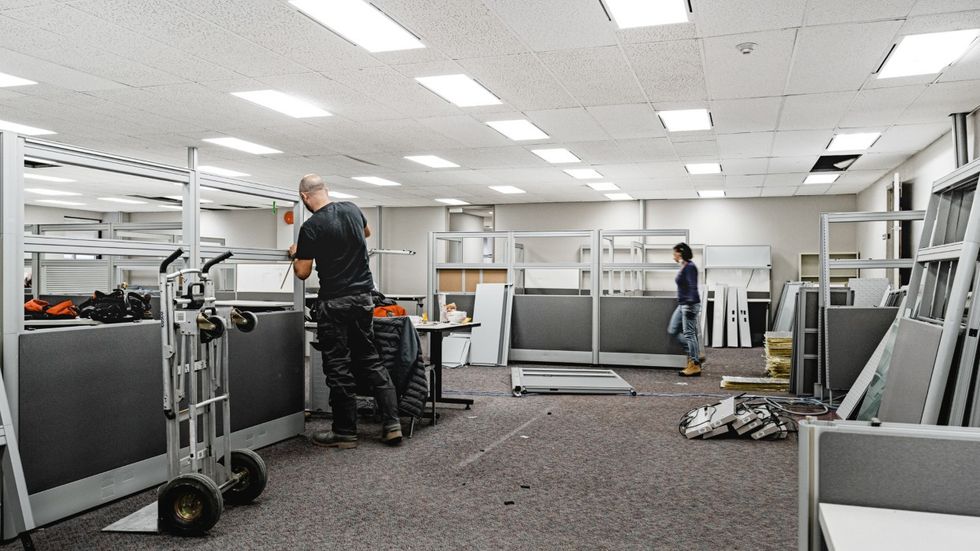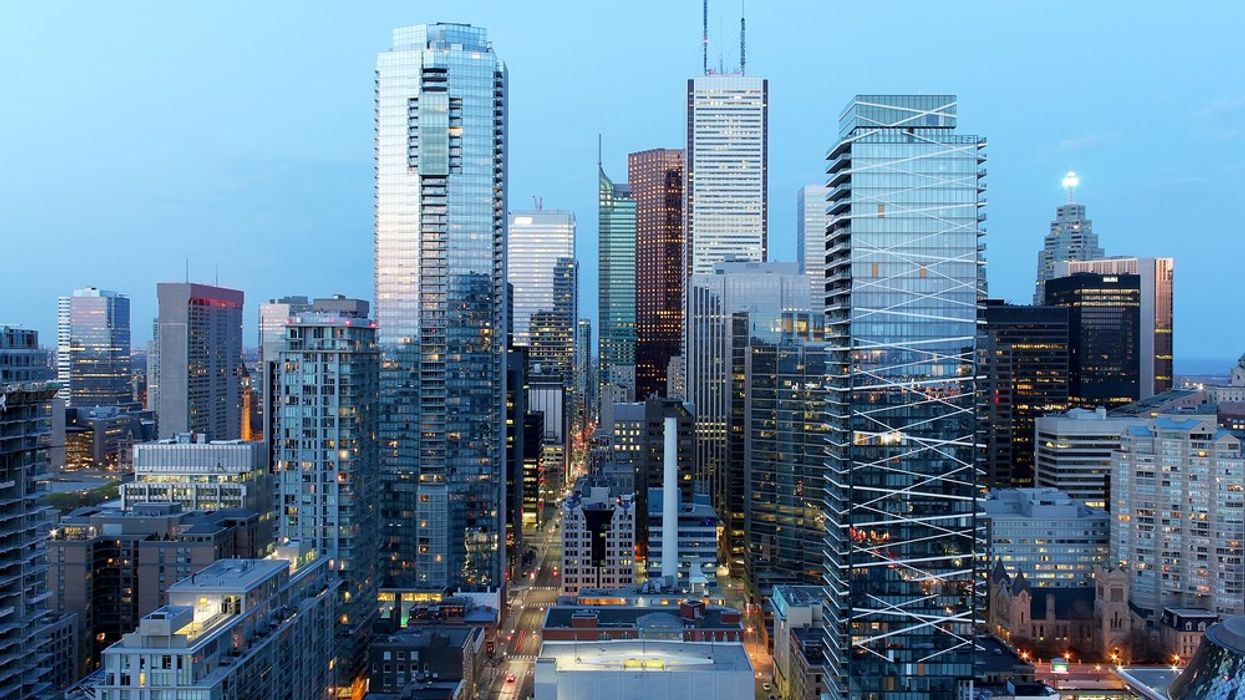The ‘Commercial Trend of the Year’ is part of STOREYS annual week-long editorial series. You can find the rest of our 2023 selections here as they're released throughout the week.
When STOREYS examined the state of office conversions at the end of 2022, there were few great examples outside of Calgary and few signs that converting excess office space into apartments was going to gain any traction in Canada.
What a difference a year can make.
"Honestly, it's probably not even the year; it's probably more so the last six to nine months that people have started taking it really seriously," says Steven Paynter, Principal and Building Transformation & Adaptive Reuse Leader for Gensler, the architecture and design firm. "It's gone from being a few projects to everyone looking at it. Nine months ago we had looked at about 250 buildings and now we're over 1,000, so it's accelerated incredibly quickly and people are taking it really seriously, which I don't think they were [before then]. Last year, I was talking about [office conversions], but no one else was, and now everyone has jumped on board."
Gensler, which has over 30 offices across North America, became deeply involved in office conversions — often also referred to as adaptive reuse — in 2019. Paynter, based in Toronto, says many of their clients started seeing a dip in property values around that time, with many asking Gensler what they could do with their assets.
Paynter kept hearing people say that office conversions were not viable, but he knew that they were, because Gensler was at that exact time completing some conversion projects in the United States. Thus, Paynter and his team began trying to come up with solutions and a way to address those concerns, and ultimately created a propriety algorithm that can quickly assess a building's physical characteristics and provide a good sense of whether it is viable for conversion. (Without the algorithm, assessing a building can take three or four months.)
Then, COVID-19 hit and everyone started "freaking out" about office buildings, Paynter recalls. They managed to finish their algorithm in 2020, with their first collaboration being with the City of Calgary, which had one of the most dire office markets in Canada at the time.
Gensler ran Downtown Calgary's office buildings through their algorithm and concluded that about 3,000,000 sq. ft could be converted. The City came back and said that they wanted 7,000,000 sq. ft — all vacant — converted, so Gensler figured out the financials behind closing that gap, and helped create the City's now-famous incentive program.
"There was a post-9/11 program in Lower Manhattan that created about 77,000 units, but the bylaw for that expired and didn't get renewed," says Paynter. "Kansas City had done a small program as well. But of the kind of COVID-related ones, Calgary was really the first. And the quickest. And, most importantly, the simplest. It's literally like $75 per sq. ft, you apply, you get approved, and you're done. All of the other cities are stacking tax rebates, with incredible financing, with low-interest borrowing — just piles of crap, honestly. Calgary's unique in its simplicity and its ease of application. The developers love it because it's a yes or no answer and it's a quick application process and that's it. That gives them certainty and reduces the risk."
"[Calgary] really saw it as a bigger problem — a downtown vibrancy problem rather than a building by building problem," he adds. "Individually, I think the buildings that are happening in Calgary aren't necessarily special, but the fact that there's 17 of them in one small city is really pretty incredible. Individually, the projects are nice, but it's really the en masse [concept], and that's what's going to bring vibrancy and life back into the city. The 'trend' is more important than the individual projects."

Since then, Gensler has brought that concept to well over a dozen cities across North America, assessing over 1,000 buildings across North America and currently working on over 350 active projects, and much of the progress that has been made in Canada this year in terms of increasing awareness and adoption of office conversions can be traced directly to Gensler and Paynter.
In April, the City of Edmonton began its work to create its own office conversion incentive program akin to Calgary's, as its office vacancy continues to increase. In October, the City of Toronto also started its own process towards creating an office conversion incentive program. Both explicitly cited Calgary as the model to follow — proof of concept that conversions can be done en masse — and Gensler is involved with the efforts in both cities, with more to come, including Ottawa.
"It's got to happen in Ottawa," Paynter says. "The federal government says it's gonna get rid of half their office space, so that's gonna really cause a huge problem for the lower end of the market. It's gonna have to happen, otherwise the real estate market is gonna be kind of devastated. In Toronto, it's obviously going to happen. The B and C buildings are highly vacant and we have huge population growth, so the ability to deliver homes more quickly by conversion is really significant. Hopefully the legislation gets sorted out in the next couple of months to allow that to happen. People are designing them now and they're ready to go. They're just waiting for the City to catch up, honestly."
Canada as a whole also needs to catch up to the US, both in terms of sheer quantity and interest. The US' lead in terms of quantity is largely the result of the US having more cities, Paynter says, and specifically more secondary cities, which are really struggling. The latter, interest, perhaps recently hit an all-time high after the White House announced actions on the federal level to support office conversions. (Gensler was involved and Paynter visited the White House, which he says was a "surreal experience.")
"I actually think, per capita, we'll see more in Canada," says Paynter, "and that's really because our housing crisis is significantly worse. The US is lacking about seven-ish million homes and Canada is lacking about 4.6 million, but the population of the US is 10 times what it is here. We also have a much better immigration policy, so our housing crisis will get even worse here even more quickly, which will drive more conversions to happen because it's a quick way of introducing housing."
"We're nowhere near the ceiling," he adds. "There's been a drop in the amount of [housing] units delivered across North America this year and that's really a hangover from the start of COVID, where no design was happening. If there was no design happening two years ago, that means there's no buildings being delivered today. We're kind of in a period like that right now because projects aren't financing properly, but I think next year — hopefully with some changes in interest rates and new incentives — we'll see it really start to boom and the trickle of projects that's happening now will turn into a flood."

Paynter says he expects to see more "overbuilds," where an existing building is retained and used as a podium for a newly-constructed tower above, akin to the 1 St. Clair West project Gensler is currently working on in Toronto or The Post in Vancouver. Overbuilds make sense because it allows the most amount of density to be squeezed out of the site, Paynter says, while retaining important components such as the heritage value and existing carbon. He says there are about three or four such overbuilds happening in Toronto at the moment and he expects that number to reach a dozen in the first part of 2024.
That latter component, existing carbon, is also another reason why adaptive reuse has gained steam this year.
"The embodied carbon of the existing buildings is becoming a huge part of the reason why people want to do these projects," Paynter says. "On average, based on the buildings we've looked at, it's about 6,000,000 kgs of embodied carbon you save, per project, just from keeping the concrete in place. We added it to our metrics about six months ago and now everyone's like 'Oh, that's great, I can borrow against that, I can sell that to our Board.' It's become a major talking point. The concrete industry is 8% of all global carbon emissions and steel is 11%, so it's incredibly significant savings if you can keep the concrete in place."
Paynter is asked about office conversions a lot and he thinks there are still a few misconceptions. Many still think that it just isn't possible. Others, Paynter says, get stuck on the "weirdest" things, such as what to do with plumbing, since washrooms in office buildings are typically clustered together, rather than scattered like in residential buildings. (The answer: you strip it out and put in new plumbing like you would a new building.) Then there are the concerns about losing job space, which Paynter says he has seen with the City of Toronto.
"I think it's a really misconstrued idea, honestly, because the buildings we're taking out... people don't want them. They were built pre-internet so they're not really infrastructurally set up for how modern offices work, so I don't really see that as an issue. Those buildings should go, they should be converted, and then when there is more demand for office, build new office — the kind of office that people want. Imagine if office space really starts to come back in five years, and you're like 'Okay, great, have this 70s building with 8-ft ceilings, it's kind of dark, and it's not insulated.' No one wants that.'"
Looking forward, Paynter says through the work Gensler has done and the work others, such as the Brookings Institute, has done, they're estimating that the amount of space that can be converted in a given city is about half of the vacancy. If the office vacancy is 15% in Toronto, for example, 7% of the existing office space can be converted, and he expects much of that work to happen in the coming year, building on the momentum that was gained this year.
In other words, 2023 was the year where we learned that office conversions are possible, 2024 will be about figuring out what's required to make them happen in larger and larger numbers.
"This is a trend and I think we're at least five years away from the peak," says Paynter. "And part of that is just because the projects take three years. We'll be designing more and more of these in the next two years, and you'll see more and more of them getting built between 2025 and 2027, and hopefully we'll still be talking about it then."



















